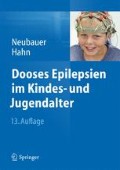Zusammenfassung
Als Gelegenheitskrämpfe bzw. akut symptomatische Anfälle werden epileptische Reaktionen im Rahmen akut entzündlicher, toxischer, metabolischer und traumatischer Erkrankungen bzw. Schädigungen des Gehirns verstanden. Sie sind bei Kindern der ersten 5 Lebensjahre infolge der in dieser Altersstufe erhöhten Anfallsbereitschaft besonders häufig. Die Inzidenz beträgt in dieser Altersstufe 3,9% (Hauser et al. 1993).
Access this chapter
Tax calculation will be finalised at checkout
Purchases are for personal use only
Literatur
Berkovic SF, Heron SE, Giordano L et al (2004) Benign familial neonatal-infantile seizures: characterization of a new sodium channelopathy. Ann Neurol 55:550–557
D’Ambrosio R, Perucca E (2004) Epilepsy after head injury. Curr Opin Neurol 17:731–735
Doose H, Neubauer BA (2001) Preponderance of female sex in the transmission of seizure liability in idiopathic generalized epilepsy. Epilepsy Res 43:103–114
Doose H, Maurer A (1997) Seizure risk in offspring of individuals with a history of febrile convulsions. Eur J Pediat 156:476–482
Doose H, Tibow I, Castiglione E, Neubauer BA (1998) Febrile convulsions with focal sharp waves – a subgroup of benign partial epilepsies of childhood with multifactorial etiology. J Epilepsy 11:341–354
Doose H, Koudriavtseva K, Neubauer BA (2000) Multifactorial pathogenesis of neonatal seizures – relationships to benign partial epilepsies. Epileptic Disord 2:195–201
Doose H, Ritter K, Völzke E (1983) EEG longitudinal studies in febrile convulsions. Genetic aspects. Neuropediatrics 14:81–87
Doose H (2002) Das EEG bei Epilepsien im Kindes- und Jugendalter. 1. Aufl. Desitin, Hamburg
Fürwentsches A, Bussmann C, Ramantani G et al (2010) Levetiracetam in the treatment of neonatal seizures: a pilot study. Seizure 19:185–189
Gallagher RC, Van Hove JL, Scharer G et al (2009) Folinic acid-responsive seizures are identical to pyridoxinedependent epilepsy. Ann Neurol 65:550–556
Glass HC, Wirrell E (2009) Controversies in neonatal seizure management. J Child Neurol 24:591–599
Hauser AW, Annegers F, Kurland LT (1993) Incidence of epilepsy and unprovoked seizures in Rochester, Minnesota: 1935-1984. Epilepsia 34:453–463
Jacobi G (1992) Posttraumatische Epilepsien. Mschr Kinderheilk 140:619–623
Kharatishvili I, Pitkänen A (2010) Posttraumatic epilepsy. Curr Opin Neurol 23:183–188
Lux AL (2010) Treatment of febrile seizures: historical perspective, current opinions, and potential future directions. Brain Development 32:42–50
Maurer VO, Rizzi M, Bianchetti MG, Ramelli GP (2010) Benign neonatal sleep myoclonus: a review of the literature. Pediatrics 125: e919–e924
McIntyre J, Robertson S, Norris E et al (2005) Safety and efficacy of buccal midazolam versus rectal diazepam for emergency treatment of seizures in children: a randomised controlled trial. The Lancet 366:205–210
Miller SP, Weiss J, Barnwell A et al (2002) Seizure-associated brain injury in term newborns with perinatal asphyxia. Neurology 58:542–548
Mills PB, Surtees RA, Champion MP et al (2005) Neonatal epileptic encephalopathy caused by mutations in the PNPO gene encoding pyridox(am)ine 5’-phosphate oxidase. Hum Mol Genet 14:1077–1086
Nelson KB, Ellenberg JH (1978) Prognosis in children with febrile seizures. Pediatrics 61:720–727
Neubauer BA, Waldegger S, Heinzinger J et al (2008) KCNQ2 and KCNQ3 mutations contribute to different idiopathic epilepsy syndromes. Neurology 71:177–183
Neubauer B, Plouin P (2011) Benign neonatal convulsions (familial and nonfamilial). In: Roger J, Bureau M, Dravet C, Dreyfuss FE, Perret A, Wolf P (eds) Epileptic syndromes in infancy, childhood and adolescence (2 nd edition). John Libbey, London
Plecko B, Paul K, Paschke E et al (2007) Biochemical and molecular characterization of 18 patients with pyridoxine- dependent epilepsy and mutations of the antiquitin (ALDH7A1) gene. Hum Mutat 28:19–26
Scheffer IE, Berkovic SF (1997) Generalized epilepsy with febrile seizures plus: a genetic disorder with heterogeneous clinical phenotypes. Brain 120:479–490
Shah DK, Mackay MT, Lavery S et al. (2998) Accuracy of bedside electroencephalographic monitoring in comparison with simultaneous continuous conventional electroencephalography for seizure detection in term infants. Pediatrics 121: 1146–1154
Silbergleit R et al. for the NETT Investigators (2012) Intramuscular versus intravenous therapy for prehospital status epilepticus. N Engl J Med 366: 591–600
Silverstein FS, Jensen FE (2007) Neonatal seizures. Ann Neurol 62:112–120
Subcommittee on Febrile Seizures; American Academy of Pediatrics (2011) Neurodiagnostic evaluation of the child with a simple febrile seizure. Pediatrics 127(2):389–394
Toldo I, Calderone M, Boniver C et al (2007) Hemiconvulsionhemiplegia- epilepsy syndrome: early magnetic resonance imaging findings and neuroradiological follow-up. Brain Development 29:109–111
Uemura N, Okumura A, Negoro T, Watanabe K (2002) Clinical features of benign convulsions with mild gastroenteritis. Brain Development 24:745–749
Author information
Authors and Affiliations
Editor information
Editors and Affiliations
Rights and permissions
Copyright information
© 2014 Springer-Verlag Berlin Heidelberg
About this chapter
Cite this chapter
Neubauer, B., Hahn, A. (2014). Symptomatische und Gelegenheitskrämpfe. In: Neubauer, B., Hahn, A. (eds) Dooses Epilepsien im Kindes- und Jugendalter. Springer, Berlin, Heidelberg. https://doi.org/10.1007/978-3-642-41954-6_4
Download citation
DOI: https://doi.org/10.1007/978-3-642-41954-6_4
Publisher Name: Springer, Berlin, Heidelberg
Print ISBN: 978-3-642-41953-9
Online ISBN: 978-3-642-41954-6
eBook Packages: Medicine (German Language)

